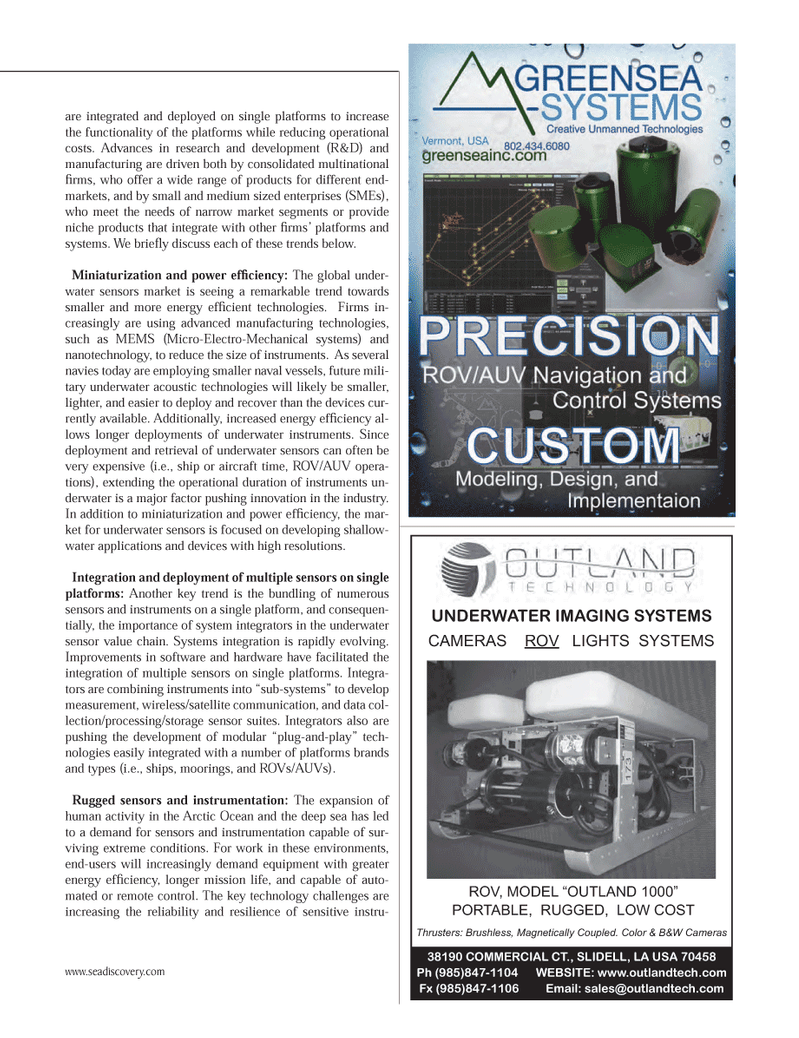
Page 39: of Marine Technology Magazine (November 2012)
Fresh Water Monitoring & Sensors
Read this page in Pdf, Flash or Html5 edition of November 2012 Marine Technology Magazine
are integrated and deployed on single platforms to increase the functionality of the platforms while reducing operational costs. Advances in research and development (R&D) and manufacturing are driven both by consolidated multinational Þ rms, who offer a wide range of products for different end- markets, and by small and medium sized enterprises (SMEs), who meet the needs of narrow market segments or provide niche products that integrate with other Þ rmsÕ platforms and systems. We brieß y discuss each of these trends below. Miniaturization and power efÞ ciency: The global under- water sensors market is seeing a remarkable trend towards smaller and more energy efÞ cient technologies. Firms in- creasingly are using advanced manufacturing technologies, such as MEMS (Micro-Electro-Mechanical systems) and nanotechnology, to reduce the size of instruments. As several navies today are employing smaller naval vessels, future mili- tary underwater acoustic technologies will likely be smaller, lighter, and easier to deploy and recover than the devices cur- rently available. Additionally, increased energy efÞ ciency al- lows longer deployments of underwater instruments. Since deployment and retrieval of underwater sensors can often be very expensive (i.e., ship or aircraft time, ROV/AUV opera- tions), extending the operational duration of instruments un- derwater is a major factor pushing innovation in the industry. In addition to miniaturization and power efÞ ciency, the mar- ket for underwater sensors is focused on developing shallow- water applications and devices with high resolutions. Integration and deployment of multiple sensors on single platforms: Another key trend is the bundling of numerous sensors and instruments on a single platform, and consequen-tially, the importance of system integrators in the underwater sensor value chain. Systems integration is rapidly evolving. Improvements in software and hardware have facilitated the integration of multiple sensors on single platforms. Integra- tors are combining instruments into Òsub-systemsÓ to develop measurement, wireless/satellite communication, and data col-lection/processing/storage sensor suites. Integrators also are pushing the development of modular Òplug-and-playÓ tech- nologies easily integrated with a number of platforms brands and types (i.e., ships, moorings, and ROVs/AUVs). Rugged sensors and instrumentation: The expansion of human activity in the Arctic Ocean and the deep sea has led to a demand for sensors and instrumentation capable of sur- viving extreme conditions. For work in these environments, end-users will increasingly demand equipment with greater energy efÞ ciency, longer mission life, and capable of auto- mated or remote control. The key technology challenges are increasing the reliability and resilience of sensitive instru- CAMERAS ROVLIGHTS SYSTEMS ROV, MODEL OUTLAND 1000? PORTABLE, RUGGED, LOW COST Thrusters: Brushless, Magnetically Coupled. Color & B&W Cameras38190 COMMERCIAL CT., SLIDELL, LA USA 70458 Ph (985)847-1104 WEBSITE: www.outlandtech.com Fx (985)847-1106 Email: [email protected] UNDERWATER IMAGING SYSTEMS www.seadiscovery.com MTR #9 (34-49).indd 39MTR #9 (34-49).indd 3911/29/2012 4:03:35 PM11/29/2012 4:03:35 PM

 38
38

 40
40
